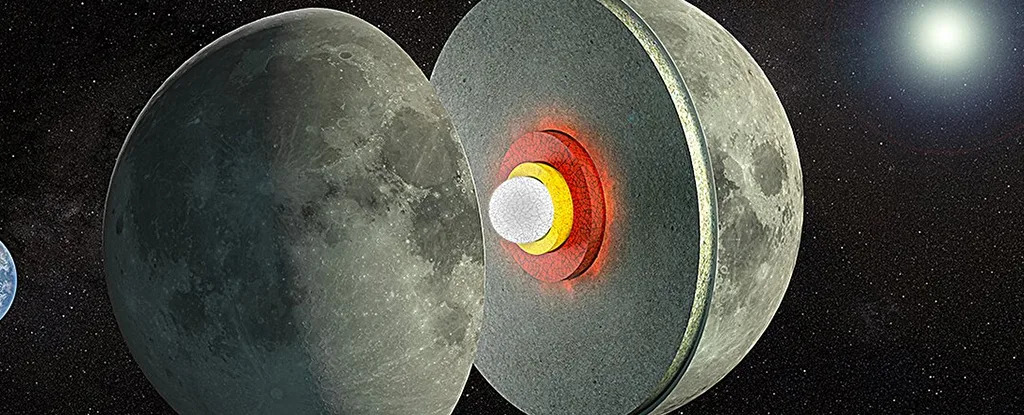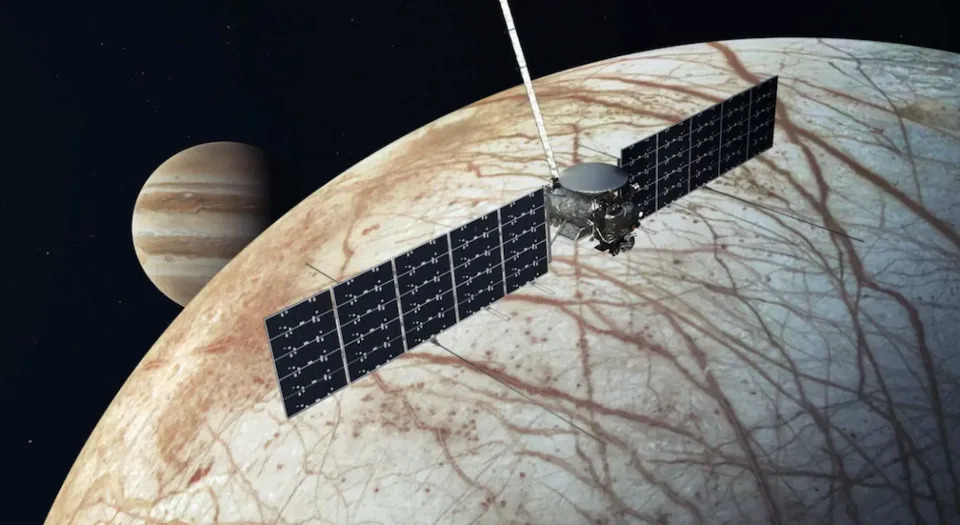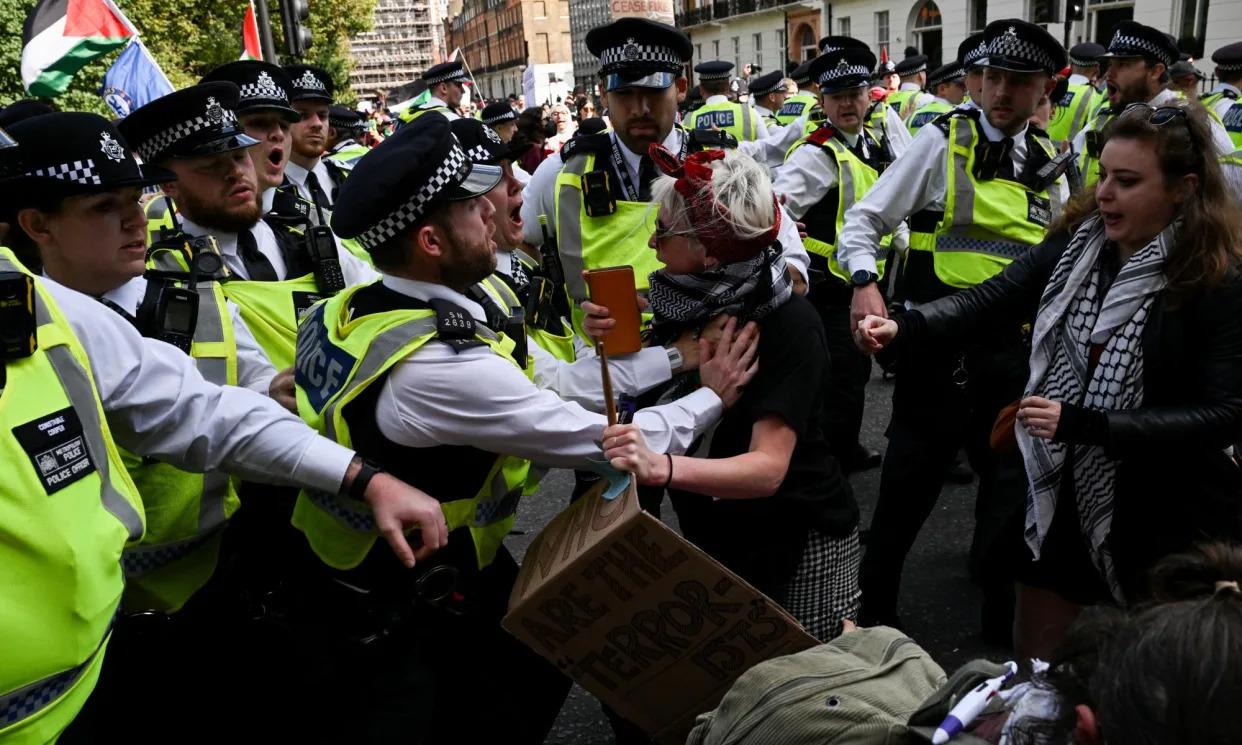Dan Kotlyar, Georgia Institute of Technology
Fri, October 4, 2024

Nuclear-powered rockets could one day enable faster space travel. NASA
NASA plans to send crewed missions to Mars over the next decade – but the 140 million-mile (225 million-kilometer) journey to the red planet could take several months to years round trip.
This relatively long transit time is a result of the use of traditional chemical rocket fuel. An alternative technology to the chemically propelled rockets the agency develops now is called nuclear thermal propulsion, which uses nuclear fission and could one day power a rocket that makes the trip in just half the time.
Nuclear fission involves harvesting the incredible amount of energy released when an atom is split by a neutron. This reaction is known as a fission reaction. Fission technology is well established in power generation and nuclear-powered submarines, and its application to drive or power a rocket could one day give NASA a faster, more powerful alternative to chemically driven rockets.
NASA and the Defense Advanced Research Projects Agency are jointly developing NTP technology. They plan to deploy and demonstrate the capabilities of a prototype system in space in 2027 – potentially making it one of the first of its kind to be built and operated by the U.S.
Nuclear thermal propulsion could also one day power maneuverable space platforms that would protect American satellites in and beyond Earth’s orbit. But the technology is still in development.
I am an associate professor of nuclear engineering at the Georgia Institute of Technology whose research group builds models and simulations to improve and optimize designs for nuclear thermal propulsion systems. My hope and passion is to assist in designing the nuclear thermal propulsion engine that will take a crewed mission to Mars.
Nuclear versus chemical propulsion
Conventional chemical propulsion systems use a chemical reaction involving a light propellant, such as hydrogen, and an oxidizer. When mixed together, these two ignite, which results in propellant exiting the nozzle very quickly to propel the rocket.

Scientists and engineers are working on nuclear thermal propulsion systems that would take hydrogen propellant, pump it into a nuclear reactor to generate energy and expel propellant out the nozzle to lift the rocket. NASA Glenn Research Center
These systems do not require any sort of ignition system, so they’re reliable. But these rockets must carry oxygen with them into space, which can weigh them down. Unlike chemical propulsion systems, nuclear thermal propulsion systems rely on nuclear fission reactions to heat the propellant that is then expelled from the nozzle to create the driving force or thrust.
In many fission reactions, researchers send a neutron toward a lighter isotope of uranium, uranium-235. The uranium absorbs the neutron, creating uranium-236. The uranium-236 then splits into two fragments – the fission products – and the reaction emits some assorted particles.
More than 400 nuclear power reactors in operation around the world currently use nuclear fission technology. The majority of these nuclear power reactors in operation are light water reactors. These fission reactors use water to slow down the neutrons and to absorb and transfer heat. The water can create steam directly in the core or in a steam generator, which drives a turbine to produce electricity.
Nuclear thermal propulsion systems operate in a similar way, but they use a different nuclear fuel that has more uranium-235. They also operate at a much higher temperature, which makes them extremely powerful and compact. Nuclear thermal propulsion systems have about 10 times more power density than a traditional light water reactor.
Nuclear propulsion could have a leg up on chemical propulsion for a few reasons.
Nuclear propulsion would expel propellant from the engine’s nozzle very quickly, generating high thrust. This high thrust allows the rocket to accelerate faster.
These systems also have a high specific impulse. Specific impulse measures how efficiently the propellant is used to generate thrust. Nuclear thermal propulsion systems have roughly twice the specific impulse of chemical rockets, which means they could cut the travel time by a factor of 2.
Nuclear thermal propulsion history
For decades, the U.S. government has funded the development of nuclear thermal propulsion technology. Between 1955 and 1973, programs at NASA, General Electric and Argonne National Laboratories produced and ground-tested 20 nuclear thermal propulsion engines.
But these pre-1973 designs relied on highly enriched uranium fuel. This fuel is no longer used because of its proliferation dangers, or dangers that have to do with the spread of nuclear material and technology.
The Global Threat Reduction Initiative, launched by the Department of Energy and National Nuclear Security Administration, aims to convert many of the research reactors employing highly enriched uranium fuel to high-assay, low-enriched uranium, or HALEU, fuel.
High-assay, low- enriched uranium fuel has less material capable of undergoing a fission reaction, compared with highly enriched uranium fuel. So, the rockets needs to have more HALEU fuel loaded on, which makes the engine heavier. To solve this issue, researchers are looking into special materials that would use fuel more efficiently in these reactors.
NASA and the DARPA’s Demonstration Rocket for Agile Cislunar Operations, or DRACO, program intends to use this high-assay, low-enriched uranium fuel in its nuclear thermal propulsion engine. The program plans to launch its rocket in 2027.
As part of the DRACO program, the aerospace company Lockheed Martin has partnered with BWX Technologies to develop the reactor and fuel designs.
The nuclear thermal propulsion engines in development by these groups will need to comply with specific performance and safety standards. They’ll need to have a core that can operate for the duration of the mission and perform the necessary maneuvers for a fast trip to Mars.
Ideally, the engine should be able to produce high specific impulse, while also satisfying the high thrust and low engine mass requirements.
Ongoing research
Before engineers can design an engine that satisfies all these standards, they need to start with models and simulations. These models help researchers, such as those in my group, understand how the engine would handle starting up and shutting down. These are operations that require quick, massive temperature and pressure changes.
The nuclear thermal propulsion engine will differ from all existing fission power systems, so engineers will need to build software tools that work with this new engine.
My group designs and analyzes nuclear thermal propulsion reactors using models. We model these complex reactor systems to see how things such as temperature changes may affect the reactor and the rocket’s safety. But simulating these effects can take a lot of expensive computing power.
We’ve been working to develop new computational tools that model how these reactors act while they’re starting up and operated without using as much computing power.
My colleagues and I hope this research can one day help develop models that could autonomously control the rocket.
This article is republished from The Conversation, a nonprofit, independent news organization bringing you facts and trustworthy analysis to help you make sense of our complex world. It was written by: Dan Kotlyar, Georgia Institute of Technology
Read more:
Is Russia looking to put nukes in space? Doing so would undermine global stability and ignite an anti-satellite arms race
To safely explore the solar system and beyond, spaceships need to go faster – nuclear-powered rockets may be the answer
How much energy can people create at one time without losing control?
Dan Kotlyar receives funding from Idaho National Laboratory and BWXT Inc. for research related to nuclear thermal propulsion.
Michelle Starr
Sat, October 5, 2024

There's nothing else like Earth and its Moon in the entire Solar System. Other planets either have multiple moons, or none at all, but the mass ratio of our world and its hefty satellite is quite unique.
The question of our unusual moon's origin, therefore, is one of planetary evolution, figuring out the pathways for various planet-moon configurations. Right now, the leading theory is that the Moon is either Earth's child or its sibling – born of the same material in the same region of the Solar System.
New research is posing a challenge to that notion, suggesting that the Moon could instead be adopted, born elsewhere in the Solar System only to be later embraced by the power of Earth's gravity.
Astronomers Darren Williams and Michael Zugger of Pennsylvania State University have crunched some numbers and found that the gravitational capture of moons is possible for terrestrial planets like Earth, and therefore a possible origin for the observed Earth-Moon system we have today.
We have a lot of evidence that Earth and its Moon are made out of the same basic material. The mineral composition of both bodies is as close to identical as you'd expect it to be if they formed from the same stuff.
The Giant Impact Hypothesis is the prevailing explanation for this similarity: Something large smacked into Earth and the resulting debris coalesced back into a planet and the Moon.
There are other ways that the two bodies could have wound up with the same composition. It may have formed in the cloud of a vaporized planet, known as a synestia, or perhaps it simultaneously formed from the same cloud of dust orbiting the Sun as Earth.
But there's more than one way to acquire a moon, as we've seen elsewhere in the Solar System. If two bodies pass each other at the correct angle and the velocity, they can become gravitationally bound together and end up in a stable, long-term orbit.
The particular scenario that might be relevant to Earth and the Moon is known as binary capture. In this scenario, two bodies that are already gravitationally bound together pass a third body. This third body snares a member of the binary pair, separating them and keeping the binary companion for itself.
We know there are lots of binary objects out there in the Solar System; we keep finding binary and even trinary asteroids, for example. There's even evidence that this three-body gravitational interaction has produced a binary capture, with Neptunian moon Triton. Triton orbits Neptune in the opposite direction from the rest of Neptune's moons, and at a different angle, suggesting it was yoinked out of the Kuiper Belt and into a wonky Neptune orbit.
The Moon, Williams and Zugger say, has an orbit around Earth that isn't as neatly aligned with the equator as you might expect from the debris cloud origin. So, they performed a bunch of mathematical modeling to determine whether something the size of the Moon could be captured by something the size of Earth.
According to their calculations, Earth could have captured something even bigger – a Mercury- or even Mars-sized object – although the orbit would not have been stable. But something the size of the Moon could have ended up in an elliptical orbit that became more circular over time, and eventually began to drift away at the same rate the Moon is receding now, at about 3.8 centimeters (1.5 inches) per year.
So, it's possible. But is it probable? There are still other properties – such as the mineral and isotope similarities – that are more consistent with a closer relationship between the two bodies than the capture scenario would allow for.
But it gives us an avenue for exploration and study that could help us understand not just our own planet, but how such systems can form in orbit around other stars, elsewhere. Since the Moon is thought to have played an important role in life's evolution on Earth, this may help us find habitable worlds elsewhere in the Milky Way galaxy.
"No one knows how the Moon was formed," Williams says. "For the last four decades, we have had one possibility for how it got there. Now, we have two. This opens a treasure trove of new questions and opportunities for further study."
The research has been published in The Planetary Science Journal.
David Nield

Molten Moon
The presence of a partially-molten layer between the Moon's rocky mantle and solid metal core is looking more likely following a study on its changing shape and gravity.
Researchers from the NASA Goddard Space Flight Center and the University of Arizona analyzed new data describing the Moon's rigidity under the gravitational influence of Earth and the Sun, finding its mass is unlikely to be solid all the way through.
Rather, the Moon's mantle has a thick, goopy zone that rises and falls like our tides.
"Interior modeling indicates that these values can be matched only with a low-viscosity zone (LVZ) at the base of the lunar mantle," write the researchers in their published paper.
The idea of this non-solid layer has been floated by researchers for several decades, but up until now the available data hasn't been able to say definitively one way or the other whether this layer is actually there.
Under the influence of Earth's and the Sun's gravitational pull, the Moon experiences a tidal effect – not in terms of oceans, but of physical deformations of the Moon's shape and gravitational field.
For this study, the team used new readings taken by NASA's Gravity Recovery and Interior Laboratory (GRAIL) and Lunar Reconnaissance Orbiter. Those measurements allowed the researchers to estimate the lunar tidal changes on a yearly basis for the first time.
Computer models describing the nature of the rock deep within the Moon's interior as it orbits Earth indicates a layer beneath the solid mantle needs to be at least somewhat viscous for the numbers to fit.
That brings up further questions: how did this zone get there? And what's keeping it hot? Further research is going to be needed to know for sure, but the team behind this study thinks the titanium-iron oxide mineral ilmenite might be involved.
"The presence of an LVZ at the lower base of the lunar mantle may be most readily explained by partial melt in an ilmenite-rich layer, which would make the Moon similar to Mars, where partial melt was recently inferred from the analysis of seismic data," write the researchers.
As with studies of Earth, some guesswork is required to judge what's hundreds and thousands of kilometers below the surface – but it's all very educated guesswork, based on what we know about moons and planets.
We know that the mantle above this LVZ is made largely from the mineral olivine, and that it's had quite a story to tell over several billion years. If we're able to establish a permanent base on the Moon in the coming years, seismic readings taken from the lunar surface itself should be able to tell us more about what's happening below the surface.
"The existence of this zone has profound implications for the Moon's thermal state and evolution," write the researchers.
The research has been published in AGU Advances.
October 5, 2024
Evrim Yazgin
Cosmos science journalist
NASA’s James Webb Space Telescope has discovered a unique supernova which has helped measure the Hubble constant – the rate at which the universe is expanding.
Several research papers have been published from the observations of the supernova, dubbed Supernova H0pe. These papers can be accessed from this NASA blog post announcing the discovery
Supernovae are the bright, powerful explosions caused by the violent death of a massive star.
“It all started with one question by the team: ‘What are those 3 dots that weren’t there before? Could that be a supernova?’” says University of Arizona astronomer Brenda Frye.
The points of light were not visible when the Hubble telescope imaged the same cluster in 2015.
“Initial analyses confirmed that these dots corresponded to an exploding star, one with rare qualities,” Frye adds. “First, it’s a Type Ia supernova, an explosion of a white dwarf star. This type of supernova is generally called a ‘standard candle,’ meaning that the supernova had a known intrinsic brightness. Second, it is gravitationally lensed.”
Gravitational lensing is a consequence of the characteristics of the universe described by Einstein’s general theory of relativity. Massive objects – like galaxies – warp space-time around them, bending the trajectory of light.
When objects line up, this creates a lensing effect which can magnify more distant objects.
In this case, the lens consists of 3 galaxies sitting between us and the supernova, bending the supernova’s light into 3 images.
“This is similar to how a trifold vanity mirror presents 3 different images of a person sitting in front of it,” Frye explains. “Since each path had a different length, and light travelled at the same speed, the supernova was imaged in this Webb observation at 3 different times during its explosion.”
“Trifold supernova images are special: The time delays, supernova distance, and gravitational lensing properties yield a value for the Hubble constant. The supernova was named SN H0pe since it gives astronomers hope to better understand the universe’s changing expansion rate.
SN H0pe is tethered to a galaxy which existed about 3.5 billion years after the Big Bang. It is the most distant Type Ia supernovae observed.
Researchers around the world made independent observations of SN H0pe using models of how the galaxies might have lensed the light from the supernovae.
“Since the Type Ia supernova is a standard candle, each lens model was ‘graded’ by its ability to predict the time delays and supernova brightnesses relative to the true measured values,” Frye says.
“The team reports the value for the Hubble constant as 75.4 kilometres per second per megaparsec, plus 8.1 or minus 5.5. [One parsec is equivalent to 3.26 light-years of distance.] This is only the second measurement of the Hubble constant by this method, and the first time using a standard candle,” Frye adds.
“This is one of the great Webb discoveries, and is leading to a better understanding of this fundamental parameter of our universe.”
“Our team’s results are impactful: The Hubble constant value matches other measurements in the local universe, and is somewhat in tension with values obtained when the universe was young,” she adds.
3-member Shenzhou-18 crew, currently aboard China’s Tiangong space station, to return in late October after 6-month mission
Serdar Dincel |05.10.2024 - TRT/AA

ISTANBUL
Space missions in China are gathering steam with a new manned mission set for later this month when the three-member crew of Shenzhou-18 returns home.
China Manned Space Agency (CMSA) released the exterior design of its red-and-white suit space suit last weekend, during a ceremony in southwestern Chongqing.
CMSA said the new Shenzhou-19 crew members will take control of space operations from the Shenzhou-18 taikonauts who are preparing to return home after conducting six months of research in space.
Ye Guangfu, teammates Li Cong and Li Guangsu of the Shenzhou-18 crew are currently aboard China's indigenously built Tiangong space station.
Ye is a fighter pilot and veteran astronaut who took part in the Shenzhou-13 mission in 2021.
The trio launched on April 25.
Shenzhou-18 is the 32nd mission of China's manned space program and the third manned mission during the operation and development stage of China's space station.
The Shenzhou 19 flight will mark China’s 14th crewed spaceflight and the 19th of the Shenzhou program.
The new crew that is set to be launched from the Jiuquan Satellite Launch Center in Inner Mongolia is composed of three People's Liberation Army Astronaut Corps, locally known as taikonauts, on the eighth flight to the Tianhe core module.
Tianhe core is the first module of the Tiangong space station.
China unveiled the name of its new spacecraft in February that will take astronauts on a lunar mission expected by the end of the decade.
The Mengzhou spacecraft and Lan Yue lunar lander will be China’s moon mission.
The white moon-landing spacesuit, expected to be ready before 2030, was showcased at the third Spacesuit Technology Forum held Sept. 28 by the China Astronaut Research and Training Center in Chongqing.
The red stripes on the upper limbs are inspired by the ribbons of the renowned flying apsaras from Dunhuang art, while the stripes on the lower limbs resemble the flames of a rocket launch.
It is designed to protect against the harsh thermal environment and lunar dust while the suit’s helmet features a panoramic, anti-glare visor, in addition to a separate long and short focal length camera.
The suit has a multi-functional integrated control console on the chest.
Chinese state media said the suit draws inspiration from traditional Chinese armor embodying "resilience, strength, and dignity, reflecting the courage and pioneering spirit of the Chinese people."
Adding more feathers to its cap, China's Chang'e-6 mission successfully returned in June, bringing 1,935.3 grams of soil and rocks, the first-ever from the far side of the moon.
In recent weeks, however, there have been a few rocket launch failures.
Mashable
Sat, October 5, 2024

A view of the icy, cracked surface of Jupiter's moon Europa.
NASA's about to launch a huge spacecraft to a world harboring voluminous seas.
Planetary scientists suspect Jupiter's moon Europa contains an ocean at least twice the size of Earth's. The Europa Clipper probe — which is the length of a basketball court and the largest craft the agency has sent on a planetary mission — is slated to blast to this distant realm on Oct. 10. Before the launch, NASA released a new detailed view of the moon's cracked surface, which shows why for decades researchers have been drawn to this tantalizing place.
"It's perhaps one of the best places beyond Earth to look for life in our solar system," Cynthia Phillips, a NASA planetary geologist and project staff scientist for the space agency's Europa Clipper mission, told Mashable.
SEE ALSO: NASA scientist viewed first Voyager images. What he saw gave him chills.
On Oct. 2, NASA shared the view below, which was taken from data gathered by the Galileo mission in 1998. It shows a close-up of Europa's chaotic landscape, which is evidence that something below the moon's thick icy crust — like an ocean — is stoking lots of change and deformity. Salty water may escape to the surface along fractures, leaving telltale reddish colors on Europa's ground. And irregular chunks of ice have likely been created by relatively recent surface movement.
"This region sports ice rafts that look like those at Earth's poles, where large chunks of ice break away and float freely on the ocean," the agency wrote. "Much of the region bears the reddish/brownish discoloration seen here — the same as seen along many of Europa's fractures. Scientists believe this material may contain clues about the composition of an ocean beneath the icy surface, if it is proven to exist."

A region on Europa called "Conamara," which demonstrates the icy moon's chaotic surface. Credit: NASA / JPL-Caltech / Orion Moon

An artist's conception of the Europa Clipper spacecraft flying by the ice-covered moon Europa. Credit: NASA / JPL-Caltech
To prove whether an ocean exists and if it could host suitable conditions for life, Europa Clipper will make around 50 close flybys of the moon's surface. It's fitted with a number of high-resolution cameras, a ground-penetrating radar, and even a device (called SUDA) that will literally sample particles of Europa that have been ejected into space by tiny meteorites.
After looping through the solar system on a 1.8-billion-mile (2.9-billion-kilometer) journey, the craft will arrive at Europa in 2030, and spend 3.5 years collecting unprecedented data. To determine if the Jupiter moon is habitable, mission scientists need to answer some major questions. For example, all life needs energy: Does this ocean world provide an energy source? And does it harbor the basic chemical ingredients, like carbon, to form the building blocks of life as we know it?
And, if all those conditions are satisfied, is there evidence the ocean has been around for billions of years, providing a stable environment for life to evolve and sustain itself in Europa's dark sea?
We'll find out.
No spaceplane in the payload, but it won't be a wasted mission
Fri 4 Oct 2024
Updated United Launch Alliance's (ULA) Vulcan Centaur is ready to blast off from Florida this morning, the second flight to space for the rocket.
While the mission, dubbed Cert-2, was originally set to carry Sierra Space's Dream Chaser, delays with the spaceplane have meant that ULA opted to lift-off with an inert payload instead.
ULA needs to get that second attempt under its belt to certify the vehicle for lucrative US national security payloads.
The Vulcan Centaur is ULA's replacement for the Atlas V and Delta IV launchers. Its maiden voyage – which ran later than scheduled, in part due to the slower delivery of the Blue Origin BE-4 engines used to power the first stage – went ahead in January 2024. Named Cert-1, the rocket was carrying Astrobotic's Peregrine lunar lander.
After giving up the wait for Dream Chaser, which should arrive at some point in 2025, ULA is instead going to use a mass simulator along with some experiments and demonstrations to ease the vehicle's passage to US Space Force certification.
According to ULA boss Tory Bruno, ULA waited for Sierra Space until "the last minute," which meant the company was unable to integrate payloads from other customers keen on a ride to orbit.
The variant of the Vulcan Centaur being launched today features a pair of solid rocket boosters strapped onto the first stage, which is powered by two BE-4 engines, each producing 550,000 lbf (2.4 meganewtons) of sea level thrust. Each solid rocket booster contributes an additional 459,600 lbf (2.044 meganewtons) of thrust at lift-off.SpaceX's
Dream Chaser mini-shuttle set to take flight at last
Sierra Space bursts full-scale inflatable space habitat module
Peregrine bows out with a bang as SLIM aims for Moon's rocky runway
According to Bruno, ULA decided on a heliocentric disposal of the upper stage – leaving it in an orbit around the Sun – after some "experimental maneuvers."
If all goes well, ULA aims to launch two more Vulcan Centaur rockets in 2024 before ramping up the cadence in 2025. ULA is planning for an ambitious 20 launches, split between the outgoing Atlas V and the Vulcan Centaur. These aren't SpaceX-level numbers, but considerably more than ULA has managed in the past.
The three-hour launch window opens at 1000 UTC, and there is currently an 80 percent chance that the weather will cooperate. A Wet Dress Rehearsal (WDR) earlier this week, where the rocket was fueled and a countdown performed to just before engine ignition, went well.
The next step will be to ignite the engines and stand back a few hours from now. ®
Updated to add at 1232 UTC, October 4
After a slight delay, the Vulcan Centaur successfully lifted off from Space Launch Complex-41 at 1125 UTC. Five minutes and 30 seconds later, the first stage was jettisoned, and the Centaur V upper stage took over to send itself and the inert payload into an initial parking orbit around the Earth.
Richard Tribou, Orlando Sentinel
Thu, October 3, 2024

United Launch Alliance is footing the bill for the second ever launch of its Vulcan Centaur rocket, so it can finally see the payouts for the backlog of $3.1 billion worth of national security missions, something ULA cannot do until the Space Force signs off on it.
For that, Vulcan needs two successful flights.
The mission, dubbed Certifcation-2, follows the successful debut launch last January of the replacement for ULA’s family of Atlas and Delta rockets. It’s set to lift off from Cape Canaveral Space Force Station’s Space Launch Complex 41 during a three-hour window that opens at 6 a.m. Friday, and backup opportunities during the same window on Saturday.
“It has literally one primary objective, which is to go fly a second time and have another success,” said ULA CEO Tory Bruno on Wednesday.
Space Launch Delta 45’s weather squadron forecasts an 80% chance for good conditions, which drops to 75% in the event of a 24-hour delay.
After January’s flight, Bruno had said Cert-2 could fly as early as April, but it was awaiting its original targeted payload, the Sierra Space Dream Chaser spacecraft that was trying to make its debut flight to deliver cargo to the International Space Station.
“They just need a little bit more time, and they could not be ready to fly just quite yet,” Bruno said.
Instead, Vulcan is flying with a mass simulator within the rocket’s upper Centaur stage, that won’t be deployed, but will allow ULA to collect the data it needs to hand over to the Space Force so the rocket can be given to OK to begin the backlog of National Security Space Launch (NSSL) contracts that need to be flown by 2027.
“We do need to certify to support our national security space customer, who has missions that are relatively urgent,” Bruno said.
So without a paying customer, ULA is taking on the cost.
“Being as transparent as I can, it’s high double digit. It’s high tens of millions of dollars,” he said.
In addition to the 25 of 26 remaining missions (one flew on an Atlas V this summer) won during what’s known as the Phase 2 contract for NSSL missions, ULA is competing for the new Phase 3 contract alongside SpaceX and newcomer Blue Origin.
“Proposals are in, and they’re being evaluated, and questions are being asked, being answered and so on,” he said. “We feel we’re in a very good position for that.”
The government originally said the five years of missions to be assigned in the Phase 2 contracts would come out so 60% would go to ULA and 40% to SpaceX. Because of delays to Vulcan, though, as the missions were doled out, the final year of the Phase 2 awards that came in late 2023 made the mission assignments closer to 50/50, giving only 11 to ULA and 10 to SpaceX.
For all five years of the contract, 48 missions worth more than $5.6 billion were ordered, and the final tally was ULA getting 26, or just over 54% worth just over $3.1 billion, and SpaceX getting 22, which is just under 46%, worth just over $2.5 billion.
The contracts for the first of five years of Phase 3 awards are expected to be announced soon, with a portion of at least 30 missions over the five-year run to be doled out at the start of each fiscal year, which began Oct. 1.
Even without the Phase 3 contracts in hand, ULA has a heavy manifest with its remaining NSSL missions as well as commercial customers including Amazon and its Project Kuiper that needs to launch thousands of its internet satellites to form a constellation that can compete with the likes of SpaceX’s Starlink.
“The performance of that system promises to be pretty amazing,” Bruno said of Project Kuiper. “I’m planning to get it at my house, because I live out in the country. My internet’s not great.”
Amazon has eight of ULA’s remaining Atlas V rockets under contract to get the first of what’s planned to be 3,236 broadband satellites sent up across up to 92 launches over five years. The first of those is slated for early 2025, Bruno said.
Amazon also ordered 38 more launches of Vulcan, and ULA has other commercial customers lined up for Vulcan as well.
Vulcan, though, was originally supposed to fly as early as 2019, but faced design hurdles as well as delays in delivery of the new BE-4 engines created by Blue Origin.
Vulcan takes two BE-4 engines, which along with up to six solid rocket boosters provided by Northrop Grumman, give Vulcan more power than either Atlas V or the now retired Delta IV Heavy, with 3.6 million pounds of thrust on liftoff.
After a long delay in getting the first two engines from Blue Origin for Cert-1, ULA is in a better place with their supplier. Except Blue Origin also needs to crank out BE-4 engines for its own rocket New Glenn, which takes seven of them, and its debut flight is planned for as early as November.
“Before they began delivering to New Glenn, they completed all of their deliveries for 2024, to me, which was their CEO Dave Limp’s promise to us, and he kept his promise,” Bruno said. “They took a — I’ll call it a holiday — from delivering to us while they populated the New Glenn.”
Bruno said that Blue Origin, though, has switched back to producing for ULA.
“Within a few weeks, my deliveries will resume again, and they’ll begin delivering engines to me now this year that I need for next year,” he said. “They are going to stay ahead of my flight schedule.”
That schedule calls for up to 20 launches, half of which roughly will be Vulcan, in 2025, Bruno said. An additional 24 Vulcan rockets are already in the works at various points of construction at ULA’s factory in Decatur, Alabama.
That pace will continue to grow as ULA completes a second Vertical Integration Facility (VIF) so it can process two rockets at once at Space Launch Complex 41. That will allow ULA to perform up to 25 launches per year from the Space Coast while also bringing its California launch site at Va
Wales says no to space wars
Dylan Lewis-Rowlands from CND Cymru explains why opposition is growing to a proposed military site in Wales.
When the Ministry of Defence announced Brawdy in Pembrokeshire as their preferred site for a deep space radar site, we were disappointed, but not surprised. Following centuries of Welsh land and air being militarised for the benefit of the state, the notion that the new frontier for war – space – will be fought partially from Wales probably came naturally to those over in the so-called MOD.
What might’ve been more surprising to us is where they chose to site this element of the Deep Space Advanced Radar Capability (DARC) programme – in a national park noted for its extraordinary natural beauty, where the economy is propped up by tourism and leisure. It is also a site that has seen opposition to development before. In the late 80s and early 90s, a campaign known as PARC – Pembrokeshire Against RADAR Campaign – forced the Thatcher government to very publicly cancel a RADAR development in Cawdor due to overwhelming public opposition. The stage is set therefore for a rematch: the UK government vs the new PARC against DARC.
The DARC development poses many threats to Pembrokeshire and Cymru in addition to the political. Such a massive development could easily choke a local economy so reliant on tourism and leisure. A site like this, constantly broadcasting signals into the sky and space, lit up so brightly, could devastate local wildlife, including the endangered bird the Manx Shearwater. The development also creates a definitive military target – with DARC being the most advanced space tracking facility available to the Americans (yes- it’ll be run by America), it is a logical target for attack for the opponents of the dying imperial hegemon.
I’ve only briefly outlined some of the threats DARC poses – there are many more. But we hope to stop the proposals in their tracks. At a local ‘PR’ event that could only be described as an unmitigated disaster for the MOD, local campaigners and activists turned out to demonstrate their opposition. At a packed event a few months prior, even more came to the launch of the PARC against DARC campaign.
This proposal, much like the proposal of the 80s, can be defeated. But it requires us to show up. It requires peace campaigners and local communities to unite as before. We will not lie down and accept this. We will turn up to future PR events, we will oppose the granting of planning permission, we will show just how ferociously Cymru yearns to be a Nation of Peace. I hope you will join us.
- Dylan Lewis-Rowlands is the National Secretary of CND Cymru
- For more information on the campaign see www.parcagainstdarc.com
- If you support Labour Outlook’s work amplifying the voices of left movements and struggles here and internationally, please consider becoming a supporter on Patreon.
At T-plus 35 minutes and three seconds, the engines of the Centaur V upper stage were fired up again to take the upper stage and its inert payload to deep space and into an orbit around the Sun.
Darren Orf
Tue, October 1, 2024
POP MECH

A Wobble in Mars’ Orbit Could Detect Dark MatterDigital Art - Getty Images
One theory surrounding dark matter is that it isn’t an exotic particle at all, but instead a collection of primordial black holes formed during the Big Bang that’ve been zipping around the cosmos ever since.
Now, a new study posits that scientists could potentially detect one of these hypothetical intergalactic travelers as it zoomed through the inner Solar System by measuring a “wobble” in Mars’ orbit.
Unfortunately, a primordial black hole would likely perform a flyby like that only once every decade, and sorting through the data to detect the influence of this passing microscopic black hole would be a herculean task.
Less than 20 percent of the matter in the known universe is the kind of stuff that we can see and interact with. The rest is made up of the perennial mystery of physics—the yet-to-be-detected dark matter. While many physicists theorized that dark matter is some form of exotic particle (like an axion, for example) other ideas look back to the Big Bang to explain dark matter’s origin story.
According to one theory, it was in the first moments of... well... everything that the universe formed microscopic black holes known as primordial black holes (PBHs). Instead of forming from collapsed stars like your typical, run-of-the-mill black hole, these structures would’ve formed from a collapse of gas and then spread throughout the cosmos as the universe expanded and cooled. If this is the case, a team of scientists from MIT and University of California, Santa Cruz (UCSC) argue that you should be able to detect near-flying PBHs by measuring the orbit of Mars. A study detailing this technique was published this week in the journal Physical Review D.
“Given decades of precision telemetry, scientists know the distance between Earth and Mars to an accuracy of about 10 centimeters,” MIT’s David Kaiser, a co-author of the study, said in a press statement. “We’re taking advantage of this highly instrumented region of space to try and look for a small effect. If we see it, that would count as a real reason to keep pursuing this delightful idea that all of dark matter consists of black holes that were spawned in less than a second after the Big Bang.”
The idea came from an innocent question: What would happen if a PBH passed through a human? If they exist (PBHs are still very much hypothetical objects), scientists estimate that these black holes could be as small as an atom, but as heavy as the largest asteroids. The team estimated that the force of these objects colliding with a person could push someone roughly 20 feet in about a second. While the odds of such a collision are unfathomably small, an interaction with a planetary system—or even the inner Solar System—could be a much bigger (and therefore much more likely) target.
The team crunched some numbers, and theorized that PBHs would likely pass through the inner Solar System at some point once a decade or so. Using detailed models of the Solar System, the researchers then analyzed whether an asteroid-mass black hole could have a detectable effect on Earth or the Moon. It turns out that noticing such an impact on our planet or its satellite would be too uncertain—but Mars, on the other hand, showed promise. If a primordial black hole passed within a few hundred million miles of the Red Planet, then a few years later, the planet’s orbit would have shifted by the small (but technically detectable) distance of about a meter.
Of course, even this planetary detection method comes with a few shortcomings.
“We need as much clarity as we can of the expected backgrounds, such as the typical speeds and distributions of boring space rocks, versus these primordial black holes,” Kaiser said in a press statement. “Luckily for us, astronomers have been tracking ordinary space rocks for decades as they have flown through our Solar System, so we could calculate typical properties of their trajectories and begin to compare them with the very different types of paths and speeds that primordial black holes should follow.”
This method would rely on quite a bit of luck, as a passing PBH would need to travel through a particular path, and hunting for that signal in real data could be a pretty daunting task.
For now, the team is calibrating their models to simulate more and more objects in order to test close encounter scenarios with more precision. Once that process is complete, they’ll be ready if (or when) a primordial remnant of the Big Bang decides to drop by our Solar System for a quick visit.



















